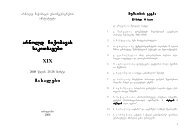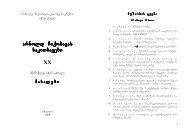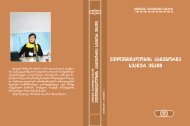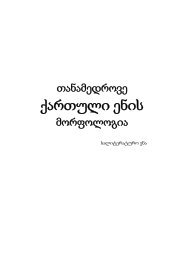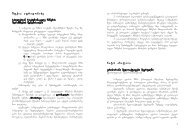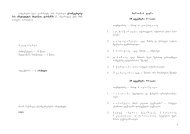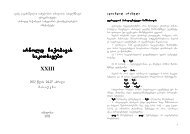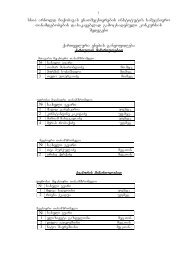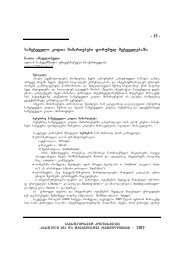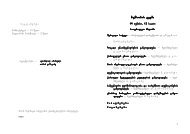5 r. a b a S i a (Tbilisi) bgeraTSesatyvisobis erTi rigisaTvis qarTvelur ...
5 r. a b a S i a (Tbilisi) bgeraTSesatyvisobis erTi rigisaTvis qarTvelur ...
5 r. a b a S i a (Tbilisi) bgeraTSesatyvisobis erTi rigisaTvis qarTvelur ...
You also want an ePaper? Increase the reach of your titles
YUMPU automatically turns print PDFs into web optimized ePapers that Google loves.
Some verbs of the middle voice can form I special form of the perfect<br />
construction from the present tense stem that creates homonymic forms with appropriate<br />
active voice verbs. For example: ”mo<br />
mous<br />
usve<br />
vene<br />
nebia,<br />
dagvi<br />
gviZi<br />
Zine<br />
nebia,<br />
gauxa<br />
xa-<br />
rebia,<br />
gaumar<br />
marJve<br />
vebia<br />
bia” may belong to active voice as well as to middle voice.<br />
In modern Georgian the loss of the marker of the theme was inhenced by<br />
the disappearance of the homonymy.<br />
Also in the works of the Middle Ages, as well as in old Georgian, the special<br />
form of the past tense is used as the basic stem for the II special form of the<br />
perfect tense construction of transitive verbs,thus causing the appearance of – e-<br />
prefix in certain passive forms: ”ra<br />
ramin ZiZas Zas daeKena da eubnebo<br />
boda<br />
da”.<br />
In certain cases the verb carries the character of homonymy according to<br />
the grammatical category of person. For example :the verb such as: ”vkmar<br />
vkmarvarT,<br />
varT,<br />
vGir<br />
irsvarT<br />
svarT” (we are quite enough; we are honoured) can be used as having one<br />
form or two forms in different contexts. For example: ”yabu<br />
bukad erTad,<br />
Gmer<br />
merTo,<br />
kma ariano<br />
no”, “mo<br />
momrek<br />
mreklad da mesro<br />
srolad<br />
Kve<br />
velas vkmarvarT<br />
varT”, ”ar<br />
Girs varo<br />
pirsa<br />
yvre<br />
vretad<br />
tad”, “si<br />
siku<br />
kudil<br />
dilsa aGara<br />
a<br />
Girs varo<br />
ro”, ”ra<br />
rasa<br />
saca vin Gir<br />
irsa,<br />
Gmer<br />
m<strong>erTi</strong><br />
mas<br />
miscems<br />
scems”, “nu brZaneb, mefeo, Tqvenis Svils mefo<br />
fobas Cven vita vGirv<br />
ir-<br />
svarT”, “yve<br />
yvelas Sengan vmadli<br />
lier varT”.<br />
Certain passive forms having no markers or – d- suffix are used as the<br />
verbs having one or two forms of grammatical category of person. It is obvious<br />
in the following examples: ”rad<br />
radgan ar vcxrebi qeba<br />
basa<br />
sa”, “sa<br />
saymlis upovro<br />
robas<br />
daGon<br />
onda<br />
da”, “si<br />
sico<br />
cocxle<br />
cxlesa Cvensa vkvirde<br />
debi<br />
bi”.<br />
Some middle-active voice verbs can be used as having the meaning of<br />
one or two forms of grammatical category of person. These verbs are: daiZi<br />
Zina<br />
(man is), , iqorwi<br />
wina<br />
(man is), gaixar<br />
(Sen mas), etc.<br />
Certain transitive verbs having two or three forms of grammatical category<br />
of person are sometimes served as the examples of homonymy such as:<br />
“Semo<br />
Semosyris is mas” (he will cut it out = the verb with two forms of grammatical<br />
category of person); and “Semo<br />
Semosyris is mas mas” (he will cut it smth out =<br />
the verb with three forms of grammatical category of person). The verbs such<br />
as: ”Se<br />
Sehzels is mas“ and “Se<br />
Sehzels is mas mas”, “garda<br />
gardahKris ris is mas” and<br />
“garda<br />
gardahyris is mas mas”, “da<br />
dasdebs is mas” and “da<br />
dasdebs is mas mas”, etc<br />
follow the abovementioned rule.<br />
131



